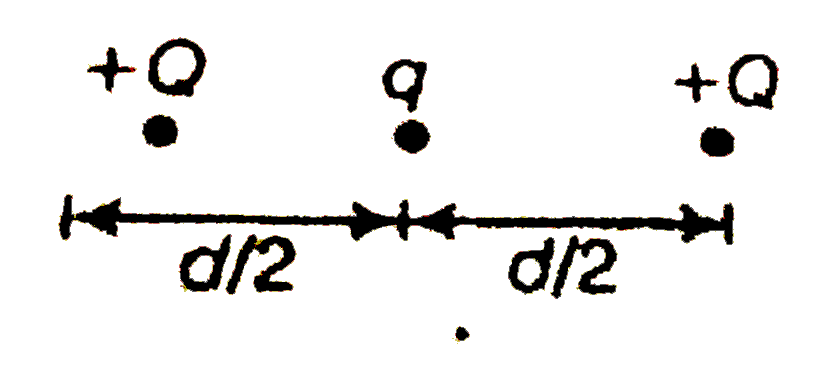A particle of mass m and +q is located midway between two fixed charged particles each having a charge +q and at a distance 2l apart. Assuming that the middle charge moves along the line joining the fixed charges, show that the frequency of oscillation when it is displaced slightly is
q2π√1πε0ml3Solution in Bengali
Step by step video & image solution for A particle of mass m and +q is located midway between two fixed charged particles each having a charge +q and at a distance 2l apart. Assuming that the middle charge moves along the line joining the fixed charges, show that the frequency of oscillation when it is displaced slightly is (q)/(2pi)sqrt((1)/(piepsilon_(0)ml^(3)) by Physics experts to help you in doubts & scoring excellent marks in Class 12 exams.
Topper's Solved these Questions
- BOOK - CHHAYA PUBLICATIONCHAPTER - ELECTRIC FIELDEXERCISE - ENTRACNCE CORNER (ASSERTION-REASON TYPE )5videos
ELECTRIC FIELD
- BOOK - CHHAYA PUBLICATIONCHAPTER - ELECTRIC FIELDEXERCISE - ENTRACNCE CORNER (MULTIPLE CORRECT ANSWER TYPE )10videos
ELECTRIC FIELD
- BOOK - CHHAYA PUBLICATIONCHAPTER - ELECTRIC FIELDEXERCISE - EXERCISE (PROBLEM SET -II)19videos
ELECTRIC FIELD
- BOOK - CHHAYA PUBLICATIONCHAPTER - ELECTRIC ENERGY AND POWEREXERCISE - CBSE SCANNER7videos
ELECTRIC ENERGY AND POWER
- BOOK - CHHAYA PUBLICATIONCHAPTER - ELECTRIC POTENTIAL EXERCISE - CBSE Scanner13videos
ELECTRIC POTENTIAL
Similar Questions
Statement I : If a proton and an electron are placed in the same uniform electron field, they experience different accelerations.
Statement II : Electric force on a test charge is independent of its mass.03:31View SolutionThe SI unit of electric field intensity is
07:50View SolutionThe charge of one of two small charged conductors is twice that of the other. The two conductors repel each other with a force of 50 dyn. If the distance between them is decreased by 3 cm, the force becomes 128 dyn. What are the magnitudes of the charges ? What was the initial distance ?
06:49View SolutionA light bulb is rated 100 W for 220 V ac supply of 50 Hz. Calculate
the resistance of the bulb ,04:33View SolutionA test charge q is moved without acceleration along the path from A to B from B to C in electric field E as shown in fig.

(i) Calculate the potential difference between A and C.13:43View SolutionA charged particle of charge 'Q' is held fixed and another charged particle of mass 'm' and charge 'q' (of the same sign) is released from a distance 'r'. The impulse of the force exerted by the external agent on the fixed charge by the time distance between 'Q' and 'q' becomes 2 r is
08:48View SolutionTwo points charges , each Q , are fixed at separation 2d. A charged particle having charge q and mass m is placed between them.
(a) Now this charged particle is slightly displaced along the line joining the charges , slow that it will execute simple harmonic motion and find the time period of oscillation.
(b) If charge q is negative and it is displaced slightly perpendicular to the line joining the charges , repeat the part (a).05:19View SolutionA charged particle of mass m having charge q remains in equilibrium at height d above a fixed charge Q . Now the charged particle is slightly displaced along the line joining the charges, show that it will executes S.H.M. and find the time period of oscillation.
10:34View SolutionTwo identical charges +Q are kept fixed some distance apart.A small particles P with charge q is placed midway between them . If P is given a small displacement Delta ,it will undergo simple harmonic motion if (i) q is positive and Delta is along the line joining the charges (ii) q is positive and Delta is perpendicular to the line joining the charges (iii) q is negative and Delta is perpendicular to the line joining the charges (iv) q is positive and Delta is along the line joining the charges
07:41View SolutionTwo small particles charged with equal positive charges Q each, are fixed apart at a distance 2a. Another small particle having a charge q lies midway between the fixed charges. Show that (i) For small displacement (relative to a) along line joining the fixed charges, the middle charge executes SHM'if it is +ve and (ii) For small lateral displacement, it executes SHM ifit is-ve. Compare the frequencies of oscillation in the two cases
View SolutionA particle of mass m and charge +q is located midway between two fixed charged particles each having a charge +q and at a distance 2L apart. Assuming that the middle charge moves along the line joining the fixed charges, calculate the frequency of oscillation when it is displaced slightly.
04:32View SolutionTwo positively charged particles each having charge Q and are d distance apart. A third charge is introduced in midway on the line joining the two charges. Find the nature and magnitude of third charge so that the system is in equilibrium.
 08:18View Solution
08:18View SolutionA particle of mass m and charge q is located midway between two fixed charged particles each having a charge q and a distance 2l apart. Prove that the motion of the particle will be SHM if it is displaced slightly along the line connecting them and released. Also find its time period.
08:52View Solutionm द्रव्यमान तथा + q आवेश का एक कण 2L दूरी पर स्थित कणो के (जिनमे प्रत्येक का आवेश + q है) बीचो-बीच रखा है। यह मान कर कि बीच वाला आवेशित कण दोनों आवेशों को मिलाने वाला रेखा पर गति करता है, उसकी दोलन-आवृत्ति ज्ञात कीजिए यदि उसको थोड़ा -सा विस्थापित कर दे।
03:53View SolutionA particle of mass m and charge q is located midway between two fixed charged particles each having a charge q and at a distance 2L apart so that distance of this charge from each charge located at end is L. Assuming that the middle charge moves along the line joining the fixed charges. The frequency of oscillation when it is displaced slightly is
03:16View Solution

